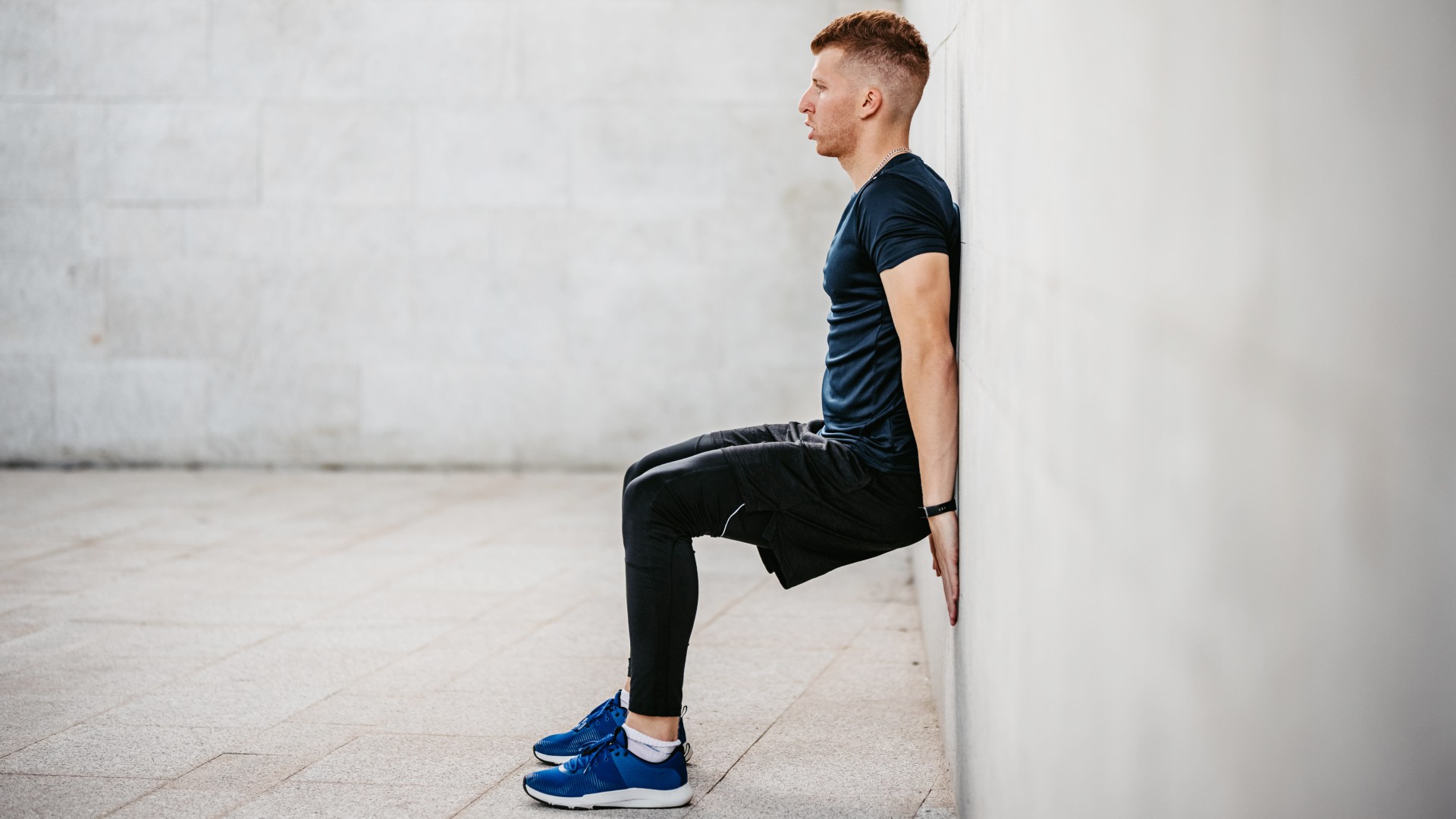
Sometimes, the day just takes over, and before you know it, you may have skipped a workout. However, there’s one move you can slot into your schedule at any time, and all you need is a wall, a ball, and your bodyweight.
This exercise builds lower-body strength and improves mobility. Because you’ll also have to control the movement of the ball as well (more on that shortly), you’ll increase thoracic mobility in your upper body and overall muscle stability. Think about engaging your core muscles and staying upright throughout, and you’ll do just fine.
If you have a Pilates ball or Swiss ball, grab it now. Otherwise, a tennis ball or similar will work.
Try this one exercise every day when you’re short on time

The wall-ball prisoner squat engages your entire body while strengthening your legs, glutes, and core muscles. By placing your hands behind your head, your body must work harder to stay upright as you squat, engaging more of the upper body as you pull your shoulder blades back to open your chest. If you have limited mobility, this will be more testing than a standard bodyweight squat.
Add the ball behind your back, and now you must focus on stabilizing the ball between you and the wall, rolling it up and down your spine as you squat and stand. This also improves the mind-muscle connection because you must stay aware of the ball and its position while you move.
Why it works
The wall-ball prisoner squat works because it focuses on multiple areas: building functional strength, engaging your core muscles, and improving overall mobility and stability. You’ll also benefit from a gentle massage of the spine and the muscles surrounding it, which can offer relief after a day spent sitting at your desk.
Performing this exercise for a few minutes daily gets the muscles moving and oxygenated blood flowing around your body, which is good for your joints and posture. This is also a compound exercise, meaning you work multiple muscles and joints together, which is more efficient and great for coordination and balance.
Get instant access to breaking news, the hottest reviews, great deals and helpful tips.
How to do it
To begin with, consider having your arms by your sides, and only progress to placing your hands behind your head when you feel ready and stable.
- Stand with your back to a wall and your feet roughly hip or shoulder-width apart
- Place a ball at your lower back, just above your glutes
- Position your hands gently behind your head and pull your shoulder blades together to open your chest and shoulders
- Keeping your chest upright and stomach engaged, bend your knees and lower into a squat, pressing your back lightly into the ball as you move; your feet will be in front of you, and your back parallel to the wall, so that you move vertically
- Keep control of the ball to prevent it from dropping. At the bottom of the squat, pause; the ball will now be at the top of your back
- Drive up to stand, controlling the ball as you do.
I recommend repeating the exercise for a few minutes, then resting and repeating for 2-3 rounds. Alternatively, complete 6-12 reps and 3-4 sets. When you become comfortable with the exercise, lift your heels and rest onto the balls of both feet throughout the exercise, engaging the calf muscles and quads. You can practice this using the high-heeled squat.
It doesn’t sound like much, but this is a powerful way to build strength, stability, and mobility with one daily exercise.

Follow Tom's Guide on Google News and add us as a preferred source to get our up-to-date news, analysis, and reviews in your feeds.
More from Tom's Guide
- I braved Jennifer Aniston’s 5-move full-body workout — here’s what happened to my core muscles
- Skip the gym — you don’t need any equipment for this 10-minute abs workout
- I've been teaching weightlifting for years — this is the exercise I see most people get injured from (and how to fix it)

Sam Hopes is a level 3 qualified trainer, a level 2 Reiki practitioner and fitness editor at Tom's Guide. She is also currently undertaking her Yoga For Athletes training course.
Sam has written for various fitness brands and websites over the years and has experience across brands at Future, such as Live Science, Fit&Well, Coach, and T3.
Having coached at fitness studios like F45 and Virgin Active and personal trained, Sam now primarily teaches outdoor bootcamps, bodyweight, calisthenics and kettlebells.
She also coaches mobility and flexibility classes several times a week and believes that true strength comes from a holistic approach to training your body.
Sam has completed two mixed doubles Hyrox competitions in London and the Netherlands and finished her first doubles attempt in 1:11.
You must confirm your public display name before commenting
Please logout and then login again, you will then be prompted to enter your display name.










